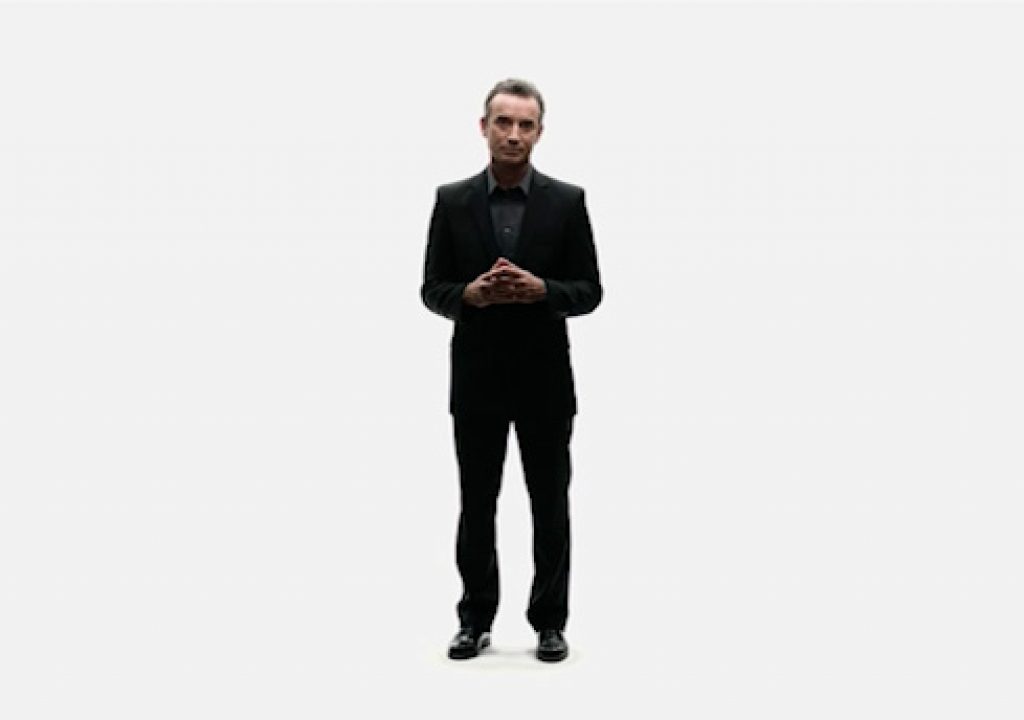The client wanted contrasty toplight against seamless white, and then they wanted to intercut that with stock footage shot on film. Thanks to Arri’s Alexa, what the client wants–the client gets. In spades.
I’ve done a number of different styles of lighting against white limbo backgrounds: flat frontal, rear 3/4, big soft source from the side… but when creative director Justin Curtis of agency GYRO:HSR told me he wanted contrasty lighting from above, I was intrigued. Many assume that because the background is white limbo the foreground lighting has to be big and bright, so it was refreshing to hear someone say that they wanted dark noir toplight.
Watch the video first, and then I’ll talk about how we did this.
Just for the record, I think this is brilliantly cut, and I love the sound design. It’s very clean and tastefully done.
A significant portion of this piece is stock footage shot on film, so it was great luck that we were able to land an Arri Alexa for this shoot. I’m both happy and sad to say that the Alexa is the film killer: sad because–well, it’s the film killer; but happy that we have a camera like this to take its place. Because the Alexa is such a filmic-looking camera I don’t feel a shift in visual styles between the Alexa footage and the intercut stock footage.
The project had to be finished in a week–the ProRes4444 footage went straight from the stage to an editing room at Teak Digital where worked started on it that night–and while there was talk of a color grade we opted to shoot in Rec 709 and get as close to the look in-camera as possible.
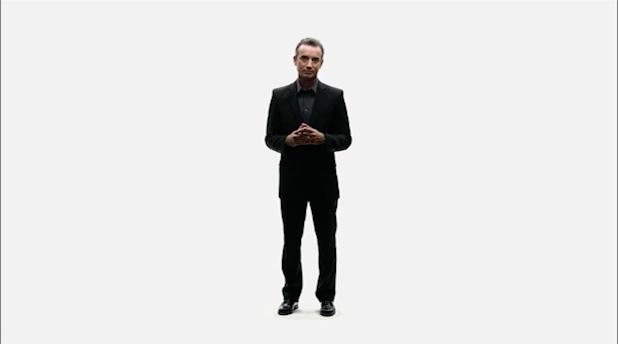
We nailed it. There was zero post color correction.
When I was first told about the dolly shot, which was to be one continuous shot from full body to tight closeup, I immediately broke out PCam and did some calculations. The calculations told me I had to do a 20′ dolly move on 24′ of track to make this shot work. (The extra 4′ gave the dolly a place to sit at the start of the move.) That influenced our choice of stages. We ended up at Bayshore Studios in San Francisco.
I knew that I wanted to be slightly wide for the closeup; I wasn’t going for beauty but for drama, so it felt right to make the talent’s face a little rounder in the closeup. Years ago, while working as second camera assistant on Texas Chainsaw Massacre III, I overhead DP Jim Carter say that the 35mm focal length lens was quite possibly the perfect lens. Later I heard a story from another DP, Robert Gagnier, who told me that when he’d shot a soap-type episodic series in the early 80s the production company allowed him two lenses for the entire shoot: a 10-1 zoom, and a 35mm prime in case the zoom broke. It seemed that a lot of people liked the 35mm focal length, and over time I’ve learned that it really is a great all-around lens: just wide enough to be interesting, not so wide as to be unpleasant on closeups.
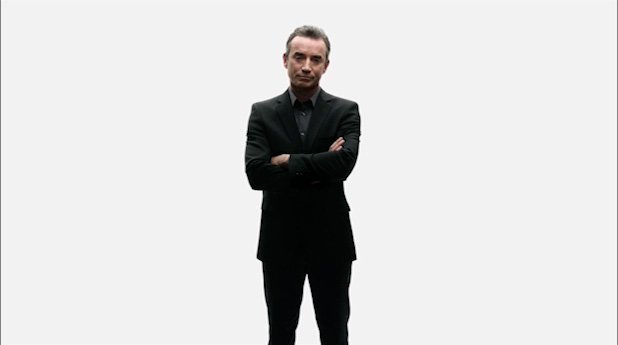
We booked a set of Ultra Primes with the Alexa, and as I suspected we’d only need one lens for the entire project I opted to drop a long lens in favor of a shorter one. The normal set consists of 16mm, 24mm, 32mm, 50mm, 85mm and 100mm, and I opted to drop the 100mm in favor of a 40mm. While 35mm felt like the right lens for the closeup, the 32mm in this set felt a little too wide–and, sure enough, when I looked at the shot on the day the talent’s face bulged a little too much. We put up the 40mm lens and the closeup was perfect.
Once the logistics of the move had been figured out we worked on the lighting. White limbo is one of the hardest things to light well because it’s very difficult to light a large surface evenly. Most often we use an array of 2k space lights for a small job like this, but a cluster of space lights will still cast a number of shadows, particularly around the talent’s feet. Gaffer Charles Griswald suggested we suspend a 20’x20′ frame of light grid cloth under the space lights, which worked perfectly. I embellished upon his suggestion by pointing out that there was no longer any need to hang the silk baskets on the space lights, so we rigged the light grid cloth underneath a series of naked 2k space lights and took advantage of the extra punch. There was some spill light that caused shadows around the edges of the frame but as long as the spill didn’t occur behind the talent we didn’t worry about it. That kind of thing is easy to fix as long as it doesn’t happen behind the talent. If the talent crosses in front of it, though, the fix will require rotoscoping instead of just slapping some flat white over the shadows. That costs more time and more money, which is not a good thing. That wasn’t a worry here as the shadows occurred at the very edges of the frame, and only on the wide shot.
It’s always important to know the parameters of what you need to accomplish. If the project had to be delivered the next day, without any post cleanup, then we would have lit the stage evenly from side to side. As that wasn’t the case we made the background perfectly even behind the talent, knowing that the edges of the white could be easily cleaned up in post. I did check with post first just to make sure they were good with that kind of cleanup, as I didn’t want to make those kinds of decisions for someone else as they’re the ones who have to deal with my choices later. It’s always good to think about the next person down the production chain.
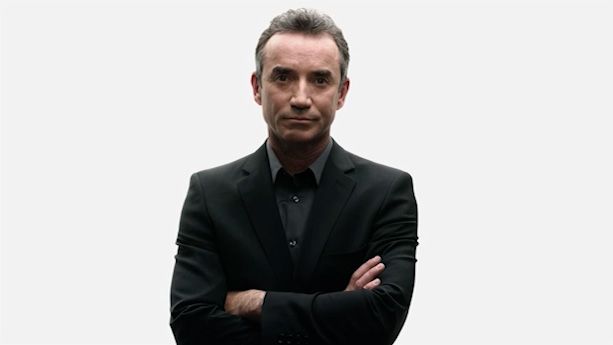
The Alexa did wonderful things with the bright, soft reflections of the overhead light in the talent’s forehead. I could have created roughly this same look with another camera but I would have had to add more fill light and a one-stop polarizer to keep those reflections from blowing out. The Alexa just handled them, the way a film stock would.
With the background lit, we focused on lighting the talent. During pre-production I’d suggested to Charles that I wanted the feel of a large china ball overhead. A 2k space light seemed like it was on the right track but just a little too small for what I had in mind. “What about a 6k space light?” Charles asked, and as soon as I heard he had one laying around I pounced on the idea. I wanted that light to be as soft as possible, without any specularity at all, so before we suspended the 6k space light over the talent I asked Charles to wrap it in 8’x8′ grid cloth. Thus the “Jellyfish” light was born:
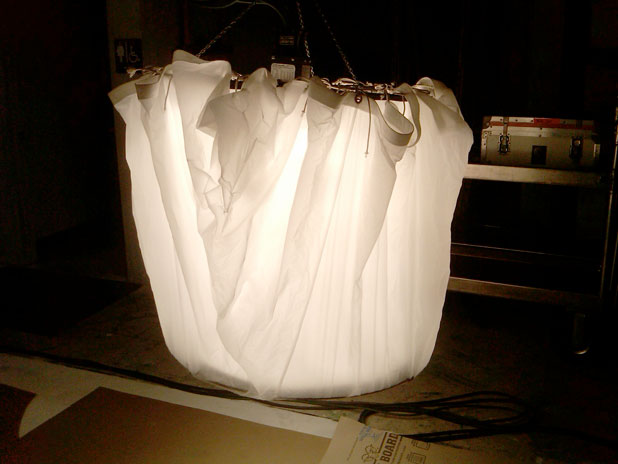
It gave off a very beautiful quality of light. As a small crowd gathered around to see what we’d done I realized I’d never seen a grip/electric crew look so stunning. That bode well for the talent.
Turn the page for more hot space light action…
Even with only one bulb on the 6k space light was a touch bright, so we placed a 4’x4′ double net underneath it. The next-to-last touch was a tweenie, hung on another goal post directly in front of the talent with Lee 216 clipped to the doors. This wrapped the toplight around the front of the actor’s face and gave him a nice eye light. And, last but not least, I wanted to add just a little bit of fill from below for the closeup at the end of the move. I asked dolly grip Ernie Kunze to rig a 1’x1′ bead board directly beneath the lens, and he rigged a white platypus clamp to a C-stand arm before heading off to find the 1’x1′. I stopped him: the white platypus clamp added just the right amount of fill, so we left it alone and forgot about the bead board.
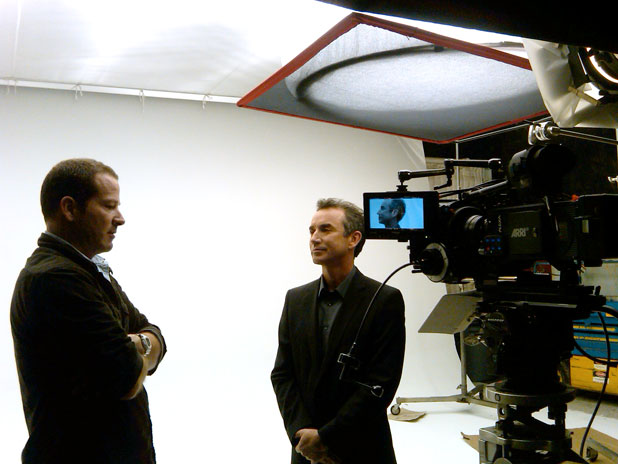
Producer Sean Cope has a chat with actor Douglas Olsson. A bunch of naked 2k space lights illuminate the cyc through a 20’x20′ frame of light grid cloth. The overhead light for the talent is a 6k space light with one bulb on, further treated with a 4’x4′ double net. At the upper right corner of the frame is a tweenie with Lee 216 on the doors to wrap the top light around the actor’s face and give him a little eye light. This light was actually in the top of frame at the beginning of the move but as it was clear of the actor it was easily removed in post. (Moving it out of the shot completely would have compromised the eye light.) The fill for the closeup is the white platypus clamp directly beneath the lens. We didn’t have to put anything in it, it was perfect on its own.
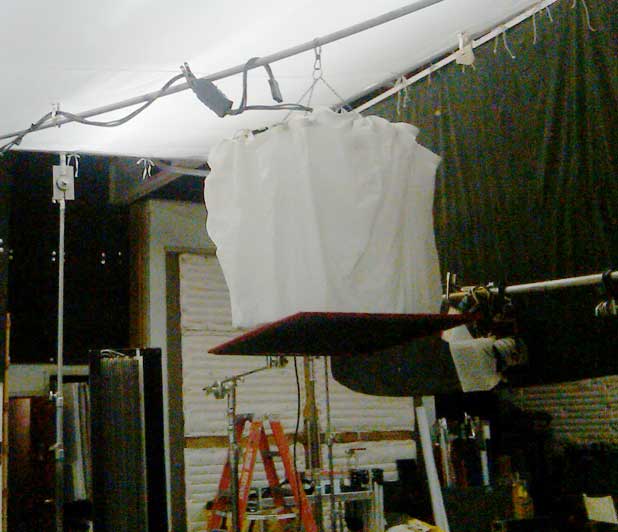
Another view of the lighting setup, during lunch with the house lights on and everything else turned off. This shot shows the large black teaser hung by the grip crew to keep the light from the 6k space light on the set and away from the client and the lens. The goal posts holding both talent lights are visible.
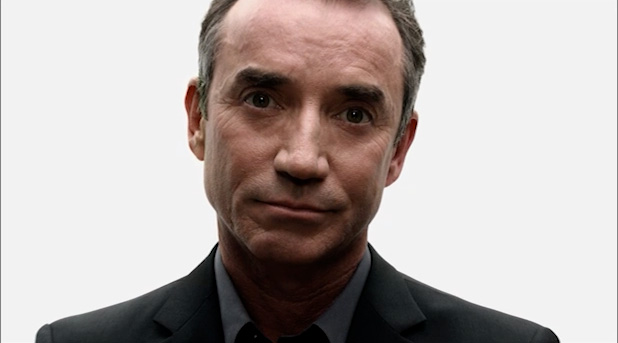
The eye light from the tweenie is plainly visible in the talent’s eyes. Because the diffused tweenie is basically an extension of the soft overhead light, we only see one shadow even though there are two lights in play.
The dolly shot took place over about 90 seconds, and we landed 2’1″ in front of the actor’s face. Having been a camera assistant, I try not to give my assistants impossible shots when I don’t have to. I rated the Alexa at EI 400, which I prefer over 800 as it’s a cleaner, less noisy look, and we lit the stage to T5.6 1/2. This left camera assistant Rod Williams plenty of time to make phone calls, send emails and run to craft service for snacks during the first 75 seconds of the move before having to concentrate completely for the last 15 seconds. Even at T5.6 1/2 he had only 1 1/2″ of depth of field at the end of the move, as the dolly slowed and came to a halt.
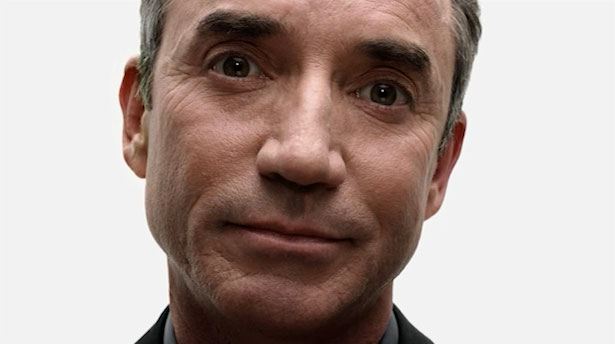
The white platypus clamp adds just a touch of fill to the closeup. You can see it reflected subtly in the lower half of the actor’s eyes.
We adjusted the speed of the dolly during the move, starting out at a higher rate of speed and then slowing as we approached the end of the track. This actually made the dolly move appear consistent in speed, rather than feeling very slow at the beginning and very fast at the end. Ernie worked out a system where he counted dolly track ties and delivered very consistently timed moves. The actor had recorded the lines the day before and we played them back during the shot for timing.
We brought the normal engineering tools in the form of a waveform/vectorscope, but we used them only to confirm exposure. There was no need to color balance the camera beyond setting the color temp at 3200k, and we controlled the contrast entirely through lighting. I had my crew arrange large black solids on the white stage nearly up to the talent’s feet, where we left a gap to allow a little bounce light from the floor to illuminate his hands from below. Blocking the white floor eliminated all fill except for what was provided either by a light or the portion of floor we left uncovered at the actor’s feet. (I didn’t want “accidental” fill; I wanted to control exactly what was filled, how much, and from where. Placement of the fill light can make a HUGE difference to a shot.)
The shoot went very quickly and smoothly, and we shot around 30 takes. Although the plan was to cut away to stock footage the director felt that it was worth the time to finesse the talent’s performance, and then he pulled what he wanted from a handful of takes. Within a week the project was delivered to a very, very happy client, who projected the piece once as an introductory piece during a large company conference.
My DIT, Jay Farrington, told me a very funny story toward the end of the day. Jay is one of the owners of Chater Camera, who provided the camera gear for the shoot, and during the day he’d been receiving phone calls from another rental house who was trying to round up another set of Ultra Primes for a project that was filming the next day. “I’m sorry,” said Jay, “but my last set is with me on a job right now. You can have it this evening, but I can’t release it any sooner.”
Later in the day he got a return call from the other rental house: “We found another set, all we need is a 40mm! Do you have one available?” “You’re in luck,” said Jay. “That’s the ONLY LENS we’re using all day!” I’m not sure what the response was but I suspect it was along the lines of “Aaaaargh!”
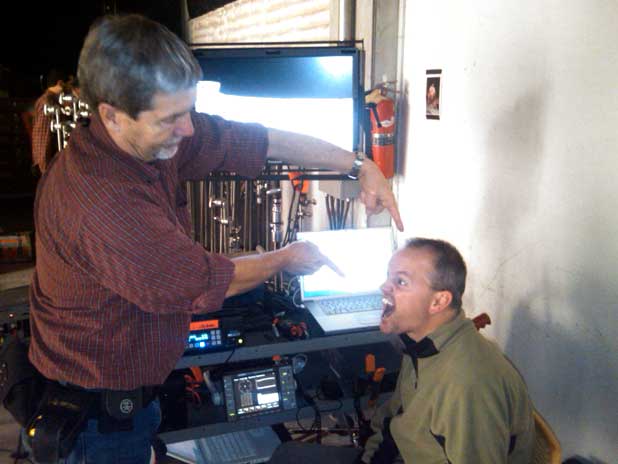
DIT Jay Farrington objects as camera assistant Rod Williams assigns blame. Hidden behind Rod is a KiPro deck. As the Alexa was unable to play back footage at the time due to software limitations, Jay recorded the HD-SDI output for playback and as an editorial backup.
Thanks to a great crew, and a great camera, we had a very productive and non-eventful day. I like shoots that keep me on my toes, but every once in a while it’s nice to do good work while being slightly under stimulated. This project went like a dream.
Director/Creative Director: Justin Curtis
Agency: GYRO:HSRTalent: Douglas Olsson
Producer: Sean Cope
Production Company: Sean Cope Pictures
Production Manager: Susan Gavet
Post: Teak DigitalDP: Art Adams
Gaffer: Charles Griswald
Dolly Grip/Key Grip: Ernie Kunze
Swing: Rick EdmondsonCamera assistant: Rod Williams
DIT: Jay FarringtonCamera package: Chater Camera (Arri Alexa and Ultra Primes)
23.98fps, EI 400, T5.6 1/2, ProRes 4444.
Art Adams is a DP wHo LiKeS a LoT oF cOnTrAsT. His website is at www.artadamsdp.com.

Filmtools
Filmmakers go-to destination for pre-production, production & post production equipment!
Shop Now